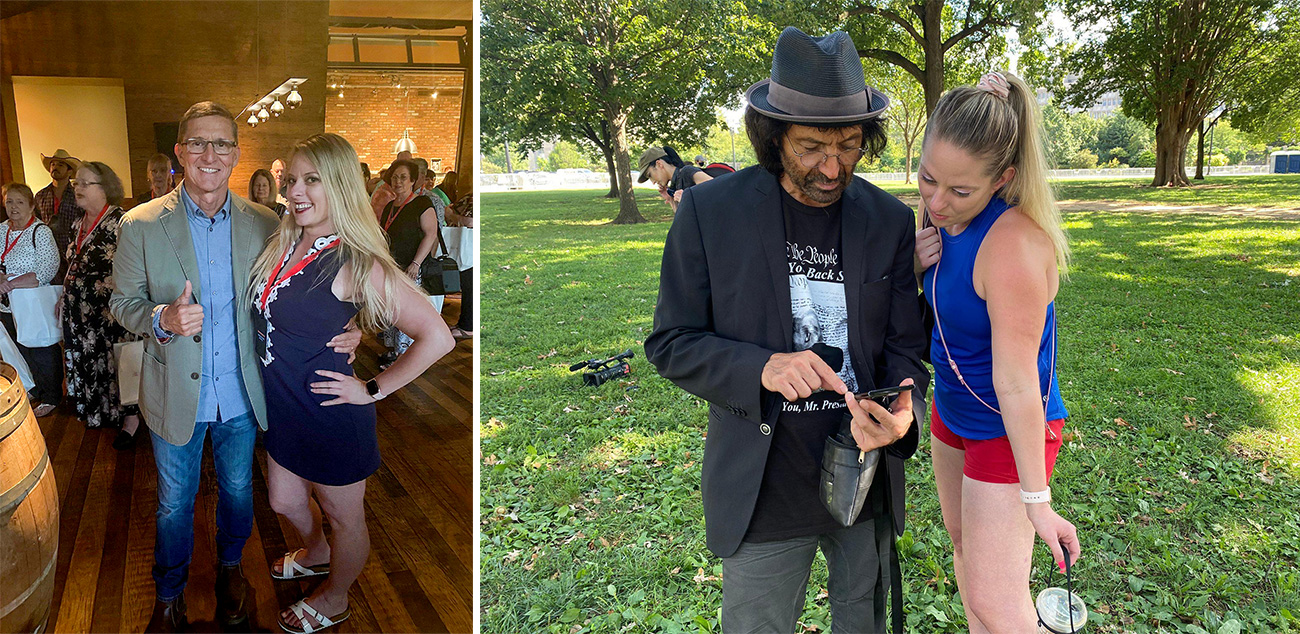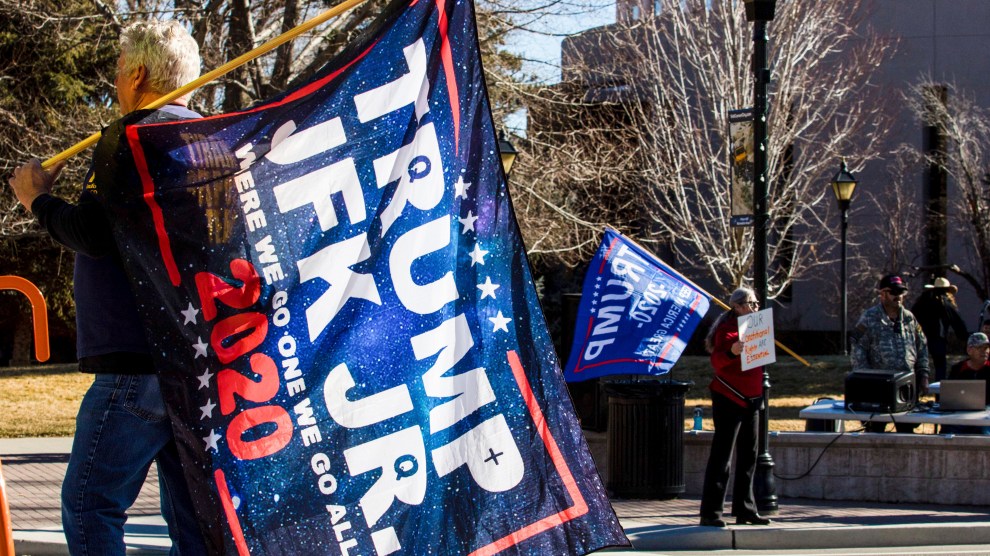“Looks like my cover is fully blown, actually, fuck,” Amanda Moore told me over Twitter direct message. It was a Saturday night in late October, and the mission that had probably saved her life was coming to an end.
She had spent months attending MAGA events across the country while undercover and after carefully constructing an alias. While she had messaged me a few weeks earlier to say the truth was trickling out, her real identity hadn’t yet spread widely. She thought it might stay that way. It didn’t.
“This was my life,” she told me a week later over FaceTime, still rattled from the project’s abrupt end. She described her situation at the beginning of the pandemic: “Before this, I thought about killing myself every day. I was not making a livable income. I couldn’t even order shit off Amazon, and the other things people were doing to keep themselves entertained and cope—because I had no fucking money.” Instead, her coping strategy was to embed deep within MAGA land.
It’s rare for a journalist to really go undercover these days. It’s possible, after facing the ethical questions—Shane Bauer did it twice for this magazine—but it’s difficult. By 18, not only do most people already have a social media presence, but both journalism schools and hiring editors usually expect reporters to put themselves out on Twitter and Facebook. Industry resources have been winnowed, and ambitious stories are often reserved for the most pedigreed and accomplished—people whose faces are pretty Googleable.
But what if you weren’t a journalist? Say, if you had the skills of an amateur investigator and the ability to focus so deeply on a single subject that you almost lose yourself to it. If you had the time, money, resources, desire, and general wherewithal, you could embed into something interesting. During the pandemic, Amanda Moore found herself fitting the bill.
My first contact with Moore was on Twitter in April 2021. A lot of people reach out if you’re a journalist, mostly to call you stupid. But sometimes they come with a bit of helpful information. Moore, who was then working under the name of KAGette (a feminized riff on Trump’s “Keep America Great”), seemed to have a lot to share. Her Twitter feed was filled with images and videos from deep inside MAGA events, spaces where most reporters would either be unwelcome or find it difficult to cover without being harassed.
Our exchange was about a video she had recorded of Dion Cini, a small-time MAGA troll and pro-Trump event organizer, who liked to pull absurd stunts like flying a Trump flag while kayaking down the Hudson along Manhattan or skating at a Central Park ice rink and getting tackled. The video showed Cini yelling “white power” at a reception after a pro-Trump boat rally he had organized that month in Tampa.
After I wrote up that story, over the next seven months Moore would occasionally let me know of other MAGA events she planned to go to undercover and on her own dime, or send pictures of herself standing next to the royalty of MAGA underworld, including disgraced retired General Michael Flynn, Roger Stone, and Vincent Fusca—a Pennsylvania man who many QAnon supporters believe is actually John F. Kennedy Jr. She was vague on the details of what she was seeing, and didn’t offer up other recordings she made to me, though some videos, photos, and tweet dispatches she made from the events and shared online got notice. “I was afraid to draw attention to myself for obvious reasons,” she says.

Moore had not initially set out to embed in MAGA world. But when pandemic shutdowns dried up her income from being a booking agent connecting models with businesses who need them for live events, she found herself with little money but plenty of free time. At first, she used it to aggressively badger DC politicians on Twitter about the slow pace of her Covid unemployment benefits, and, once they expired, the staffers of national politicians whom she held responsible for the program’s deficiencies.
Even when she was able to get benefits, the contract model-booking work didn’t count, leaving her with only about $100 a week based on a brief stint as a bartender. “I was thinking about killing myself, every day, for hours a day. That’s all I did,” Moore later told me, emphasizing that her suicidal thoughts were very real: “I reached a point where it no longer mattered to me if I lived or died.”
Things started to get incrementally better: She moved out of her basement apartment with its poor natural light and in with her mom. A small crypto investment she made based on a tip she read on 4chan paid off. Combined with her savings on rent, she now had some spare cash.
She was already a self-described leftist, with a history of attending fringe right events, either to bear witness or counterprotest. She’d turned up at press conferences in 2019 hosted by tricksters Jacob Wohl and Jack Burkman, and gone to a sparsely attended QAnon rally on the National Mall that summer. With her newfound time and money, Moore eventually decided to immerse herself in the other side. She was going to show up where the MAGA faithful and America’s nascent fascist communities gathered, and befriend them, earn their trust, become one of them—and then at the end, she was going to tell everyone about it.
Moore’s descent into the far-right was gradual and initially unintentional. When she heard about a post-election MAGA rally planned for November 2020 at DC’s Freedom Plaza, near the Capitol, she immediately decided to attend. “I’ve always made time for something like that. I grew up here so I think that morphs your brain in a weird way,” she explained to me in November 2021, at a DC bar. She had just headed over straight after a spin class—just like she had ahead of going to the rally one year before.
While she spoke quickly and intensely, she was warm and inviting, despite it being our first face-to-face meeting. I imagined how that—along with her ruthless persistence, savvy, and status as a white woman in a space that explicitly values but was short on them—helped ingratiate her with the far right.
Moore, who is 33, didn’t initially build a cover story. But she realized that if she didn’t wear a mask, held her tongue, and acted friendly, demonstrators simply assumed she was on their side, and would warm up to her and speak freely with little prompting. After the November 2020 rally and several other events, Moore realized that she was noticing things—observations that kept her from being as surprised as many people were by the January 6 storming of the Capitol.
“December was incredibly disturbing,” she explained, describing a tone of menace at the next major MAGA rally in DC that followed Biden’s victory. “It was tense all day and people were telling me about how the Proud Boys had protected and saved them at the last rally, and how the police can’t do anything”—anything meaning, she says, commit violence against counterprotesters. “I remember, this guy walking by me and saying ‘When it gets dark…’”
When the sun set, a group of men in “America Strong” hats and clothing with golden laurel wreaths—a typical Proud Boys uniform—surrounded and beat a Black counterprotestor outside of Harry’s bar, the group’s notorious DC hangout. (The protestor fought back with a knife and was arrested, along with one man who was stabbed.) Other fights broke out, as the Proud Boys, known for inciting street brawls, roamed around town. By the end of the night, four churches had been vandalized.
Amid the rampaging, Moore heard Proud Boys claim that everything beyond the domain of the MAGA rally was dangerous and riddled with antifascists looking to sow violence. “They would offer to walk me places. They offered this to old men and other women,” Moore says, describing how it created paranoia, and the impression that it wasn’t safe to move around DC without protection.
The group’s messaging seemed to have worked. That night while walking around downtown DC, Moore says she saw little critical reaction to swirling rumors about what had happened outside Harry’s even among MAGA demonstrators who weren’t themselves Proud Boys. They seemed to assume that the Proud Boys, despite their history of prompting and inciting violence, were simply doing what they had to. She says she overheard people say that while they didn’t necessarily condone violence, if a Proud Boy attacked someone “he must have had a good reason.”
While undercover, she shared some of her findings with a small number of reporters and posted others on a Patreon page where she collected funding. But what she released was only the beginning; for the most part, she held onto what she found, intending to use it after the culmination of her project— perhaps on her own, with hopes of kicking off a journalism or writing career, or maybe working with journalists she had been in contact with. Except for the Cini story, Moore and I had no agreement or discussions before she was exposed about using her surreptitiously gained material. Since she was identified, she has published a first-anniversary account of what she saw on January 6, 2020. She’s also been in contact with at least one other major publication, where she hopes to author something of a tell-all.

It became clear to Moore that her project was transitioning from a form of dark voyeurism into an all-consuming endeavor at the February 2021 Conservative Political Action Conference. The inciting moment was “when Shane Trejo asked for my phone number,” Moore told me with a smirk.
Trejo, though not well known on even the fringe of the mainstream, has tried to bridge more traditional parts of American conservatism with newer, overtly racist, fascism-supporting strains. He chairs Michigan’s 11th District Republican Committee, writes for the far-right conspiracy-mongering blog Big League Politics, and used to host a podcast called Blood Soil and Liberty with a member of the white supremacist group Identity Evropa. He is also the “grassroots director” of Republicans for National Renewal, a pro-Trump, nationalist group that has aligned with the Groypers, an informal white power group, and hosted speakers like Péter Szijjártó, Hungary’s foreign minister and a leader of its anti-democratic far-right Fidesz Party.
Before meeting Trejo, Moore had compartmentalized her expeditions into the far-right. Like a job, she went into the office and then left. But the barriers collapsed after CPAC, when Trejo, who did not respond to requests for comment, started sharing tidbits over text and bringing her to gatherings that often included nationalists and fascist-sympathizers when they were in the same place.
While Moore suspected Trejo’s outreach was at least partially an attempt to hit on her—people they knew sometimes referred to her as “Shane’s girl,” she told me—the access helped her decide to fully commit to regularly attend right-wing gatherings nationwide. “It’s like I was leading two lives,” Moore said. “I made a Facebook, Twitter, and Instagram accounts for my alter ego. I had a backstory. I made credit cards in my alias with a P.O. box to get tickets.”
Over the next several months, Moore zig-zagged to events across the country, like Cini’s Tampa gathering, conspiracy influencer QAnon John’s Patriot Roundup in Dallas, and the Pueblo County Colorado Lincoln Day Dinner. At that event, the “guest was Lauren Boebert. I was like ‘This bitch is crazy. She’s saying wild shit all the time’”—if she did, Moore wanted to be there to record it.

As she jetted from MAGA node to MAGA node, she noticed a pattern: The “fringe” that Trejo was involved in had developed a parallel world organized alongside more mainstream events. For example, she recalled attending the conservative organization Turning Point USA’s student action summit in Tampa in July, where the American Populist Union, a pro–white power group, had scheduled an event on the same day at a hotel just across the street. APU’s event started in the evening, as Turning Point’s general session was ending. “I already had a ticket for APU, but multiple people told me to make sure I got one at various events during TPUSA,” she explained. Republicans for National Renewal used the same playbook in December, holding its own event in Phoenix at the same time TPUSA hosted “Americafest.” She witnessed something similar at 2021’s CPAC conference, where white power activist Nick Fuentes held his own nearby gathering.
Trejo and his associates never bothered to wonder why or how she kept showing up and hanging out with them. Moore also stumbled onto notable figures who were often barely, or not at all, on the radar of disinformation and far-right researchers and journalists, but who had amassed significant numbers of online and offline fans—people like Brad Barton, a QAnon influencer with roughly 140,000 followers on two Telegram channels and 150,000 on Facebook. When she admitted she’d never heard of him after he came up a hotel lobby conversation, the right-wingers she was with were surprised she hadn’t. They then piled into a car together to go witness him perform a baptism.
“There is more and more cross-pollination between white nationalist influencers and QAnon influencers,” Moore told me, basing her conclusions on interactions with some of the people she spent time around undercover. When she mentioned that she would go to events attended by believers in the conspiracy, she says white nationalists she spoke with would reply, “Oh, these QAnon people are all freaks, but they’re useful.”
“There is a very clear to QAnon-to-fascist pipeline. I talked about planning that pipeline with fascists. These are people who are working with Hungarian fascists to bring their style of government into our country,” Moore says.
Mike Rothschild, author of The Storm Is Upon Us, a book about QAnon, is one journalist who was in touch with Moore while she was undercover. He says what she found shows that many on the far-right, from the bottom all the way up through its top tier of influencers, truly mean what they say.
“This is not an act. This is not a con. This is who they are,” he told me. “She would send me pics of people who were big in QAnon that she came face to face with. What she found with them is that they actually believe what they push. The facade never dropped—even in private.” Rothschild says “there’s a huge amount of value in chronicling what these people do,” likening her actions to infiltrating a far-right chatroom or Discord server. “They don’t know they’re being listened in on—but who cares? They’re extremists and grifters and anti-semites. I don’t care about hurting their feelings.”
As much as Rothschild appreciates Moore’s undercover work, he told me that he “would definitely discourage” anyone from doing the same. “It’s really dangerous,” he warns. “And if you don’t do right, you can make it worse by platforming really bad individuals and giving them a free shot at getting their nonsense out.”

Maybe you’re curious about how all of this affected Moore. When she fully revealed herself on Twitter in October after her cover was blown, some anti-extremism activists responded skeptically, wondering if someone could willingly spend so much time with the far right if they weren’t already one of them, or open to being radicalized by them. And in a way, Moore was radicalized as she spent time with the far right—but in the opposite direction.
Raised by Republicans who came to support Trump, Moore describes herself as a former teenage libertarian—an ideology she says she firmly shed after showing up at 2014 Black Lives Matter demonstrations responding to the police killing of Michael Brown, eventually settling on socialism. The lack of government help in the pandemic, which had pushed her to suicidal ideation, was part of why she had thrown herself into the underbelly of MAGA land to begin with. With the current system failing her, she says she thought “’No, it’s not far left enough. We need more.’” She now describes her politics as communist. Her own radicalism actually made being undercover simpler. “It was easier to rail on Democrats and shit on Biden,” she explained, because she sincerely didn’t like them—just for the opposite reasons of the people she was hanging out with.
While her time within the far right pushed her left, it did help her understand why others get wrapped up in right-wing, anti-Covid politics. “I objectively had more fun during the pandemic than anyone here,” she said, nodding to the other drinkers in the DC bar we were in. It was November, and, as Covid cases were down in relative terms, Washington had opened up a bit. But the city’s residents had lived under some of the country’s most rigid Covid restrictions.
“You go to these events and they’re in places like Florida, where people aren’t wearing masks at bars and the pandemic isn’t real. It was nice to talk to people about just normal shit,” she told me. “I could see how someone who did what I did and was less principled would just be like ‘Fuck it’ and go full QAnon.” While Moore believes in the efficacy of masks and usually wears them, she says the experience of wearing them “fucking sucks.” She did eventually get breakthrough Covid in July, days after she went to a right-wing social event at a bar in Tampa and hung out later that night in a hotel room with members of Republicans for National Renewal and Florida statehouse member Anthony Sabatini. His candidacy for the US House of Representatives has been endorsed by the group.
It all came to an end in October 2021, earlier than she had intended, after an employee of a QAnon influencer stumbled across an old anonymous Twitter account that had revealed her personal information. Moore has no idea who was behind the account, but because it was posted before she went undercover, suspects it was some congressional staffer who she had targeted over Covid benefits. (When working with models, she’d run a side gig, she explains, charging “gold diggers $30 an hour to research their boyfriends to make sure that they were actually rich, and not married or criminals.” Moore used those skills on the aides of lawmakers holding up pandemic relief, recalling that “they seemed very furious with me for publishing their Facebook info.”)
After connecting the dots, the influencer’s employee sent Moore a message letting her know she’d been found out. The influencer posted it on Telegram, and over the course of several weeks, the news moved through the online right, which began hurling misogynistic smears about Moore and spreading more information about her, including her and her parents’ addresses. When word got to Trejo, he blocked her on Instagram. They haven’t spoken since.
Moore canceled her plans to attend an event later that month at Trump’s Doral, Florida, resort and began reaching out to publications and journalists with what she had seen, either to pass along what she found or in the hopes of being commissioned to write about it. But she was often rebuffed, with many telling her what she had done was unethical.
Going undercover and misleading people about who you are is an ethical minefield for journalists, usually only sanctioned after careful deliberation by editors and, by the broader industry, when other avenues are exhausted or would be ineffective. But Moore didn’t see herself as a journalist and believes that she operated ethically under a broader standard of the word.
“These are people who are undermining elections. They are working to ensure that we never have anything resembling the kind of free and fair elections that we previously had,” describing, with a note of frustration, conversations she witnessed and right-wing organizers she met. “They’re literally killing people. They’re telling people to take ivermectin, to not get vaccinated. They’re encouraging people to leave their children behind, to leave their spouses behind, if that’s what it takes. They hate people who are not like them. These are people who were straight-up saying, ‘We should have repatriation. If you’re Black or brown, you should leave the country.’ And it’s like, is it unethical for me to hear them say that and report it?”
Image credits: Natilyn Hicks/Unsplash; Mike Kemp/In Pictures/Getty </> Correction: An earlier version of this story misstated which group hosted an event in Phoenix at the same time as TPUSA’s “Americafest.” The event was hosted by Republicans for National Renewal.












